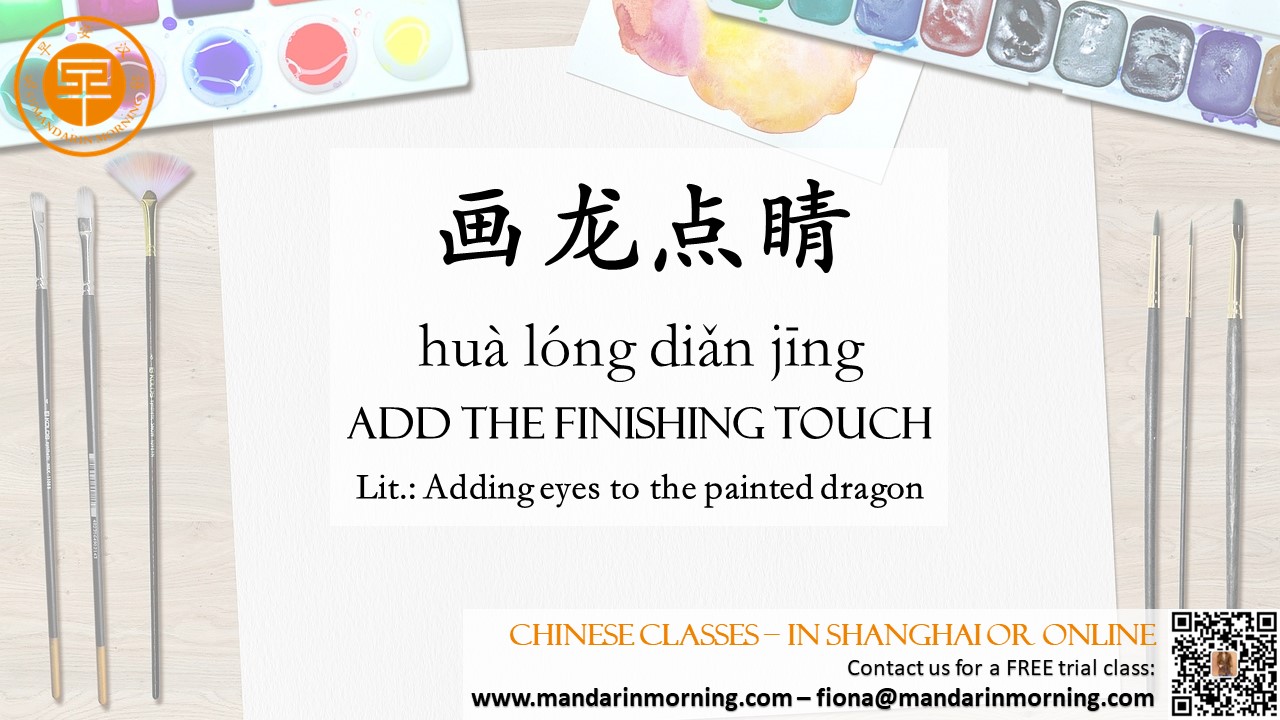| In Chinese culture, dragons are special and deeply meaningful to the people. Contrary to the frightening creatures often depicted in various tales, Chinese dragons bring good things like strength, wealth, and power. So, in this article, we will explore the dragon’s journey through the Chinese language and culture together. We will uncover five must-know Chinese dragon idioms, extending your vocabulary and revealing how the mighty dragon continues to weave its influence through Chinese culture today. This is part two of our article.  Adding eyes to the dragon 画龙点睛 Imagine meticulously crafting a magnificent dragon, only to halt before adding the final, critical touch: its piercing eyes. This conjures the ancient tale of Zhang Yanyuan (张彦远, c. 815 – c.877), a well-respected artist who painted four dragons without eyes. When questioned why, he asserted that adding eyes would bring them to life, and upon doing so, the dragons soared into the heavens, leaving behind mere empty sketches. The idiom 画龙点睛 (huà lóng diǎn jīng) embodies this principle – a meticulous detail can breathe life into everything. Break into the four characters in the idiom: 画 (huà) means “to draw” or “to paint”; 龙 (lóng) is “dragon”; 点 (diǎn) translates to “to add a dot”, and 睛 (jīng) signifies “eyes.” Hence, it literally translates to “adding eyes to the painted dragon.” This wise saying highlights how a tiny detail can make a big difference, much like the phrase “putting the finishing touches” in English. It reminds us that sometimes, one small action or thing can turn everything around, making it whole, complete, and truly alive! Example: This sentence really adds the finishing touch: 这句真是画龙点睛。 (zhè jù zhēnshì huà lóng diǎn jīng) A parade of horses and carriages 车水马龙 Imagine being in ancient China. Picture a busy street where there’s never a break in the stream of horses and carriages. 车水马龙 (chē shuǐ mǎ lóng) describes a scene just like that, where everything is moving all the time, like a river’s flow or a dragon’s tail in motion. Breaking it down: 车 (chē) means “car”; 水 (shuǐ) is “water”; 马 (mǎ) stands for “horse”, and 龙 (lóng) is “dragon.” This idiom, symbolizing an endless and vibrant movement, is often used to depict scenes bustling with life, such as a lively street or a dynamic marketplace, evoking the ever-moving energy and constant activity found within. Example: This street is always bustling with traffic: 这条街总是车水马龙。 (zhè tiáo jiē zǒngshì chē shuǐ mǎ lóng) Dragons without heads 群龙无首 Envision a flock of mighty dragons, swirling and potent yet… headless? Without direction, they flutter in chaos—a vivid display of power lacking purpose. 群龙无首 (qún lóng wú shǒu) paints this scene, speaking to scenarios where there’s might and potential but no guiding force. Breaking it down: 群 (qún) means “group”; 龙 (lóng) signifies “dragon”; 无 (wú) translates to “without”, and 首 (shǒu) refers to “head” or “leader.” Pieced together, it reads as “dragons without a head.” The idiom becomes a metaphor for scenarios devoid of leadership, spiraling into disarray and misdirection. It serves as a reminder: without a steering force, even the most formidable powers can descend into chaos and inefficacy. An interesting aside: This idiom first appeared in the classic Chinese text, Yi Jing (or Book of Changes), bearing a somewhat positive connotation initially. The original usage described someone adaptable and capable of navigating various circumstances to achieve success. Example: After he left, the company was without leadership: 他走后,公司群龙无首。 (tā zǒu hòu, gōngsī qún lóng wú shǒu) |